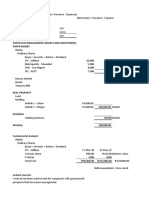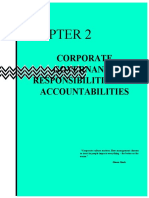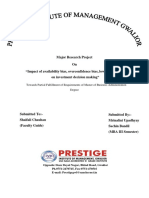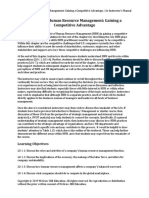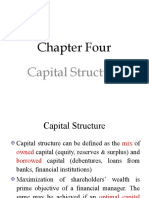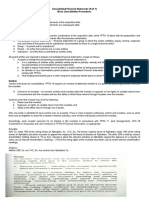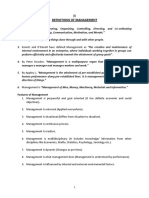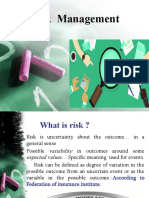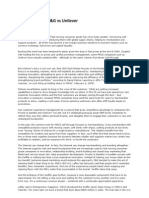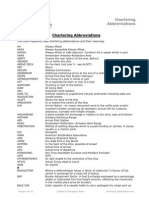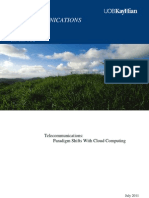Planning
Planning
Uploaded by
Nithyananda PatelCopyright:
Available Formats
Planning
Planning
Uploaded by
Nithyananda PatelCopyright
Available Formats
Share this document
Did you find this document useful?
Is this content inappropriate?
Copyright:
Available Formats
Planning
Planning
Uploaded by
Nithyananda PatelCopyright:
Available Formats
FORECASTING: MEANING Allen.L.A defines Forecasting is systematic attempt to probe the future by inference from known facts.
The purpose is to provide management with information on which it can base planning decisions. Thus, it is clear from the above definition that forecasting is the process of predicting the relevant events of future, based on the analysis of their past and current behaviour. CHARACTERISTICS: 1) It relates the future events i,e it is the calculation of probable future trends. 2) Forecasting is based on the analysis of the past and present events. 3) The past and present events are analysed with the help of some statistical and mathematical techniques. 4) It defines the probability of the happening of future events. 5) The purpose of the forecasting is to provide the management with the information needed for planning process.. DISTINCTION BETWEEN THE FORECASTING AND PLANNING: 1) The scope of planning is wider than that of forecasting, as forecasting is a part of planning. 2) Planning decides the future course of action. Forecasting just helps in planning the future course of action. 3) Planning involves a number of processes in order to arrive at a decision. Forecasting involves just the estimate of the future events. 4) The planning is undertaken by those persons whose activities affect the whole or part of the organization. Forecasting is undertaken by those persons whose activities may not affect the major part of the organization.. FORECASTING PROCEDURE OR STEPS INVOLVED IN FORECASTING. A) Understanding the problem.
B)
C)
D)
E)
The management must know the purpose of forecasting. The clear understanding of the purpose of the forecasting will help the management to probe only the relevant data. Developing the basis for forecasting for the future. The management has to undertake a detailed and systematic analysis and interpretation of the past events and develop the basis for forecasting for the future. Estimation of the future course of the action. The estimation of the future course of operations can be made with the help of statistical and mathematical techniques. The management also should make use of their knowledge, experience, intelligence, judgement and discretion. Verification of the actual results with the estimate. The comparison of the actual with the estimates regularly will be useful to know the deviations between the estimate and actual. Review of the forecasting process. The management must review the forecasting procedure so that improvements can be made in the forecasting procedure that is being followed.
IMPORTANCE OF FORECASTING: The success of business depends in a large measure upon the skill of management in forecasting. 1) 2) 3) 4) 5) 6) It helps management in planning. It helps management in decision-making. It helps management in controlling. It helps management in securing co-ordination. It helps management in budgeting. Forecasting contributes to the overall success of business by facilitating better utilisation of resources
DECISION-MAKING. MEANING AND DEFINITION:
Allenn defines Management decision-making is the work a manager performs to arrive at conclusion and judgement. Ray A Killian defines A Decision in its simplest form is a selection of alternatives. CHARACTERISTICS: 1) It is the process of choosing the best course of action from among the alternative course of action. 2) It implies uncertainty about the final results of each possible course of operation. 3) It implies freedom to the decision-maker to choose from among the alternatives without externally imposed coercion. 4) In is an intellectual process. 5) It is always purposive and goal oriented. 6) It may be positive or negative. 7) A decision may be expressed in words or may be implied from behaviour. 8) It is a blend of thinking, deciding and action. 9) It is an end process. 10) It involves certain commitment. STEPS IN DECISION-MAKING. 1) Diagnosing and defining the problem. Correct diagnosis of the real problem is of utmost importance, because a diseases can be cured only, if it is properly diagnosed. It is also said that a problem well-defined is half-solved. 2) Analysing the problem and fact-finding; The analysis of the problem helps the manager to get a clear idea of the problem. While analysing the problem, the main problem should be dissected into sub-problems, and each element in the problem must be thoroughly investigated. 3) Developing alternative solutions or course of action: Development of alternative solutions is necessary, because every problem has two or more alternatives for its solution.
4) Selecting the best course of action. The various alternative solutions should be evaluated and the best solution should be selected. The chief criteria of evaluation are: a) Economy of efforts b) Degree of risk. c) Situation and timing. d) Availability of resources and personnel. e) Consonance with the goals of the enterprises. 5) Implementing the decisions. Once the decision is taken, the decision must be translated into action or must be put into effect. It is one of the most difficult steps. Decisions have to be communicated to the employees properly and should be accepted by all employees for proper implementation of the decisions taken by the management. 6) Following up of the decisions. It means checking the results after the decision is put to use. It is necessary to find out the decision is right or wrong, implemented properly or not and to modify the decision. POLICIES: MEANING: George R. Terry, defined Policy is verbal, written or implied overall guide setting up boundaries that supply the general limits and directions in which managerial action will take place. According to Koontz and ODonnell, Policies are general statements or understanding which guide in decision making of subordinates. Characteristics: 1) Policies are formulated for the concern as a whole as well as for each of its sections and departments. 2) Policies are the basis for executive action. 3) Policies lay down the broad limits within which decisions have to be made for accomplishing the goals of the organization.
4) Policies are supplementary and complementary to objectives of the organization.
Importance of Policies: 1) They provide guidelines to thinking and action. 2) They help the subordinates in decision-making. 3) They define the area within which the subordinates can make their decisions. 4) They save the time and labour of the subordinate by pre-determining the problems.
STRATEGIES: Meaning: According to A.D.CHANDLER, Strategy is the determination of the basic long term goals and objectives of an enterprise and the adoption of courses of action and the allocation of resources to carry out theses goals. According to R.N.ANTHONY, Strategy is the process of defining the objectives of the organization, on changes in their objectives, on the recourses used to attain these objectives, and on the policies that are to govern the acquisition and disposition of theses recourses. Characteristics; 1) Strategies are the guidelines to handle specific problems. 2) They i9nvolve the finding out of a judicious combination of human resourses and physical resources to be used for achieving the goals. 3) They are formulated to meet the business contingencies such as competitors policies etc. 4) It involves taking into to consideration external and internal environment. 5) The strategies also have to be dynamic and not static. 6) Strategies are formulated by top management.
Distinction between Policies and Strategies. 1) Policies lay down the general guidelines to action. But strategies lay down the actual directions to be followed to meet business contingencies. 2) Policies are necessary under all conditions whereas strategies are necessary to overcome certain obstructions. 3) The implementation of the policy can be delegated downward but the implementation of strategies cannot be delegated. 4) Policies are written and are communicated to all levels of management. But strategies are unwritten and are confined to certain levels of management.
ORGANIZATION:
Meaning: The term organization can be used as a group of person working together or as a structure of relationship or a process of management. It means a concern, an undertaking or enterprises. Definition: Koontz and ODonnellOrganizing involves the grouping of activities necessary to accomplish goals and plans, the assignment of theses to appropriate departments and the provision for authority, delegation and co-ordination Louis A.Allen-
Organizing is the process of identifying and grouping the work to be performed, defining and delegating responsibility and authority, and establishing relationship for the purpose of enabling people to work most efficiently together in accomplishing objectives. It is clear from the above definitions that organizing is the process of defining, identifying or determining the various activities to be performed to attain the objectives of the enterprises, the appropriate grouping of the activities into logical patterns or structure to secure homogeneous groups of activities to appropriate departments and peoples, the placing of the departments in charge of suitable departmental managers, the provision of the necessary physical facilities to the departmental manager to accomplish the enterprise objectives.
NATURE AND CHARACTERISTICSOF ORGANIZATION: 1. It is a management process. 2. It is concerned with groups of people. 3. It is concerned with identification and grouping of activities into logical patterns. 4. Division of labour is the basis of organization. 5. Co-ordination of the of the various activities of the enterprises is another feature of the organization. 6. It contributes to the accomplishment of the goals of the organization. 7. It consists of various positions arranged in a hierarchy with clear definition of responsibility and authority. 8. It involves number of steps such as identifications of activities grouping of activities etc to accomplish the goals. PURPOSE OR OBJECTIVES OF ORGANIZATION.. 1. 2. 3. 4. To facilitate efficient administration. To help the management to have control over the various activities. To act as the means to solve business problems. To facilitate optimum use of the resources of the undertaking.
5. To facilitate co-ordination and communication among the departments. 6. To encourage initiative and creativity among the managers. STEPS INVOLVED IN THE PROCESS OF ORGANIZATION. 1. Determination of objectives: The objectives have to be set in general and in particular according to the requirements of each department. It helps the management not only framing the organization structure but also in achieving the enterprises objectives with minimum cost and efforts. 2. IDENTIFICATION OF ACTIVITIES. The total work of the organization has to be devided into essential activities or major functions, such as purchasing of materials, production, marketing, financing, personnel, etc. 3. Grouping of activities. The next step is the grouping of activities into divisions abd departments, and the sub-divisions of departmental activities into sections on the basis of relatedness and similarities. 4. Defining the the duties to be performed by varius departments. The duties and responsibilities of every department must be clearly defined so that there may not be any over-lapping of functions. 5. Appointment of personnel for various jobs. The next step is to appoint suitable and well-qualified persons for the various jobs in the light of the requirements of the jobs. 6. Assignment of duties to the personnel. The duties to different personnel on the basis of their specification, skill, experience and ability, and responsibility and accountability of each of the personnel has to be assigned.. 7. Delegation of authority.
Sufficient authority has to be delegated to the subordinates to enable them to carry out their duties efficiently. 8. Provision of adequate physical facilities. Adequate physical facilities have to be provided to the personnel to enable them to discharge their duties and responsibilities efficiently. 9. Establishment of authority relationship. It involves taking decisions as to superior-subordinates relationship, who will act under whom, who will be his subordinates, his span of control, his position in the organization.
ORGANIZATION STRUCTURE. Meaning: It is the basic framework within which the members of an enterprise work together to achieve the common objectives. In other words, it is the structure pattern or system of relationships among the positions and people working for the attainment of the common goals or objectives. TYPES OF O.S: There are two types of organization structure, Viz., 1. Classical or Tall Organization Structure. It is pyramid-shaped. It is characterised by: i) Centralisation of authority at the top. ii) Departmentalisation of activities. iii) Division of labour iv) Hierarchy of commands. v) Narrow span of control or supervision. vi) Distance from top to bottom. vii) Extended communication lines. viii) Impersonality. 2. Behavioural or Flat Organizational Structure. It is usually flat. It is characterised by;
i) ii) iii) iv)
More decentralisation. Wider span of control. More general supervision. Less extended communication lines.
FORMAL AND INFORMAL ORGANIZATIONS. A) FORMAL ORGANIZTION: An organization is formal when the activities of two or more persons are consciously co-ordinated towards a common objective. In short, a formal organization is one resulting from planning where the pattern of structure has already been determined by the top management. Features: a) The position, authority, responsibility and accountability of each level are clealy defined. b) It prescribes the relationships amongst the people working in the organization. c) d) It is bound by rules, regulations and procedures. It is deliberately impersonal.
e) Individuals are fitted in to jobs and positions and work as per managerial decisions. f) g) Co-ordination proceeds according to the prescribed patteren. It is based on ideal relationship.
ADVATAGES: 1) It makes everybody responsible for a given task. 2) It ensures law and order in the organization by prescribing rules, regulations and procedures. 3) It contributes to the accomplishment of the common goals of the enterprise.
DRAWBACKS; 1) It is impersonal. So it ignores emotions and sentiments of individuals. 2) It is deliberately designed to achieve the goals of the enterprise.It does not considers the goals of the individuals. 3) It has regid rules and regulations. 4) It is very difficult to find such ideal relationships. B) INFORMAL ORGANIZATION: Meaning: Informal organization is a network of personal and social relations not established or required by the formal organization but arising spontaneously as people associate with one another. FEATURES. 1) It arises from the personel and social relations amongst the people working in the organization. 2) It arises spontaneously, and not by deliberate efforts. 3) It is influenced by personal attitudes, emotions, likes and dislikes of the people in the organizations. 4) It is not based on the rules, regulations and procedures. BENEFITS: a) It helps the formal organization to make a workable system to get the work done. b) It helps the formal organization to become humanistic. c) It provides social satisfaction to group members. d) It helps the group members to attain specific personal objectives. e) Workers achieve a senses of security and belongingness. f) It is the best means of employee communication. g) It serves as an agency for social control of human behaviour. h) It lightens the work-load of the formal managers. i) It makes the managers plan and act more effectively.
DRAWBACKS:
a) The communication in informal organisation may lead to rumours. b) It mayput resistance to changes and innovations. c) It may not effectively contribute to the attainment of the objectives of the enterprises. FORMS OF ORGANIZATIONS: There are many types or forms of internal organization. They are: 1) Line, military or scalar organization. 2) Functional organization. 3) Line and staff organisation. 1) Line, military or scalar organization. Meaning: It is a type of organisation in which the relationship between the various levels of management form a hierarchy of authority or chain of command. In otherwords it is a type of organisation in which there are direct vertical authority relationship, connecting the positions at each level with those above and those below in the hierarchy. Chart showing the line organisation: AUTHORITY GENERAL MANAGER PRODUCTION MANAGER ASSISTANT PRODUCTION MANAGER FOREMEN SUPERWISERS WORKERS
RESPONSIBILITY FEATURES OF LINE ORGANISATIONS; 1) It forms a vertical line relationship from the top to the bottom of organisations 2) There is superior subbordinate relationship in the line organisation . 3) Authority flows from the top to bottom through downword deligation of authority while responsibility flows up word from the bottom to the top step by step 4) There is no provision for staff officers to offer advice to the line officers . 5) At each level the executive meke decision within the scope of his authority. ADVANTAGES 1) 2) 3) 4) 5) 6) 7) 8) It is simple to establish and operate. Responsibility and authority are clearly defined There is unity of command and control under the system . It ensures better discipline among the employees. It fecilitate quick and prompt decisions. There can be effective co:ordination of activities. Communication is and quick. Is is flexible or elastic and less expensive.
Disadvantages: 1) 2) 3) 4) 5) 6) There is no scope for specialisation . As only one manager manages all the activities , he is over burdened. There is unitary administration . There may be lack of cooperation and team spirit. There is much scope for nepotism and favouritism. The subordinate should follow the ordes of their superior without expressing their opinion on the orders. 7) It is regid and inflexible . 8) Theline authority may become autocratic or dictatorial . 9) The lower level managers loose their initiate and interest.
2) FUNCTIONAL ORGANISATIONS Meaning: It is type of organisation in which the work of the whole enterprise is divided into a number of specialised functions like production, purchasing, marketing, office management , personal relations etc and each of these specialised functions is interested to a functional expert are specialist. FEATURES; 1) It is a complex type oforganisation when compare to line and staff organisations. 2) There is a specialisation in functional organisations . 3) The line executive receives instructions not only from his line boss but also from one or more specialist. 4) The principle of unity and command is not observed. 5) More importance is given to staff specialist 6) There are three types of authority relationship viz line authority relationship, staff authority relationship and functional authority relationship in this type of organisations. ADVANTAGES 1) It ensures maximum use of the principle of specialisations and helps the enterprises to enjoy the benefits of specialisations of functions 2) This system contributes higher efficiency of workers 3) This system ensures cooperation and team work among the workers. 4) Line officers are freed from the worries of technical problems. 5) Any change in the organization can be introduced without disturbing the whole organization i,e, it is very flexible. 6) It is quite suitable for training young specialists. 7) It simplifies managerial control. DISADVANTAGES: 1) There may be many supervisory staff of equal rank which may lead to conflicts among them. 2) As there are many bosses, it is difficult to maintain discipline among the workers.
3) There may be the difficulty of co-ordination because of several functional experts. 4) The top management may find difficult to fix responsibility, when ther is unsatisfactory progress. 5) There is no unity of command under this system. 6) The system is very expensive. 7) It is very difficult to put this system into operation and it makes relationship more complex. 3) Line and staff organization: Meaning It is a type of organisation in which there are two sets of officers for administration, viz, (a) line officers who have the authority and command over the subordinates and are responsible for the accomplishment of the results and (b) staff officers or specialist who render expert advice to the line officers to help them to discharge their functions efficiently. Features: 1) It is a combination of line organization and staff (functional) organization. 2) It makes a clear distinction between the two aspects of administration i,e, planning and execution. 3) It is based on the principle of specialisation. Advantages: 1) 2) 3) 4) 5) Specialisation is ensured. It has greater flexibility. It benefits the entire organization. There will be sound managerial decisions under this system. The line officer will get more relief under this system.
Disadvantages: 1) There may be conflicts between the line and staff officers. 2) The advice of staff officer may be ignored by line officer.
3) This system may encourage carelessness on the part of the staff officers. 4) Due to appointment of a large number of staff officers it becomes quite expensive. 5) It is not suitable to small concerns.
DEPARTMENTATION OR DEPARTMENTALISATION
Meaning: Departmentalisation is a process of deviding the large monolithic functional organization into small and flexible administrative units.---Knoontz and ODonnell. It is the efficient and effective grouping of jobs into meaningful work units to co-ordinate numerous jobs all for the expeditious accomplishment of the organizations objectives.George R.Terry. Importance and advantages: 1) 2) 3) 4) 5) 6) 7) 8) It contributes to systematic distribution of work among individuals. It contributes to the attainment of specialisation. It simplifies managerial skills. This makes the executives alert and efficient. It increases the operating efficiency of the organization. It provides sufficient scope for growth and expansion. It increases the prestige of the manager It is helpful to the management to evaluate the performance of the various departments. 9) It facilitates proper supervisions. 10) It makes budget preparation easy. 11) It contributes to performance appraisal.
12) 13)
It facilitates effective control. It contributes to the development of managerial personnel.
Limitations or disadvantages. 1) The greater number of departments , the more difficulty will be the task of co-ordination. 2) The work of communication becomes mor difficult. 3) There is also the problem of supervision and control. 4) It is expensive in terms of money and efforts. 5) Loss of morale on part of the subordinates affects the overall results of the organization adversely Methods of Departmentation. There are many bases of departmentation. They are: 1) 2) 3) 4) 5) 6) 7) 8) 9) Departmentation by functions or purposes. Departmentation by products or services. Combination of functional and product departments. Departmentation by regions, areas or territories. Departmentation by customers. Departmentation by processes. Departmentation by time. Departmentation by numbers. Departmentation by marketing channels.
1) Departmentation by functions or purposes. The activities of an organization are grouped into major functional departments like production, sales, purchase, personnel, financial departments etc and each department is headed by by an executive, who is directly responsible to the top executive. Advantages: 1) It is simple and easy to understand.
2) 3) 4) 5) 6) 7)
It is economical. It is the natural and logical method of grouping activities. It contributes to occupational specialisation. It facilitates inter-departmental co-ordination. It facilitates effective performance control. It helps in effective utilisation of human and other resources.
Drawbacks: a) A manager becomes an expert only in handling the problems of a particular function only. b) There may be internal friction among the departmental managers. c) It overburdens the managers with work and responsibility. d) It does not facilitate overall development of managers. e) Because of excessive centralisation, it is unsuitable where geographical centralisation is required. f) It is unsuitable where emphasis on product line is required. 2) Departmentation by products or services. A separate department for each major product is established and is placed under the charge of of a separate manager under this method. It is also know multi-functional product departmentation. Advantages: a) Helps the management to focus attention on the manufacture and sale of each individual product. b) It helps determine the performance of each product line. c) Salesmen will have deeper product knowledge and this will contribute to better customer service. d) It offers motivation to the managerial personal for improvement and expansion it facilitate effective coordination and control. e) The top management can get detailed and specialised information about the market for a specific product. f) A new product line can be added without disturbing the existing operation g) It is suitable for large organisations having different types of products
DRAWBACKS; a) b) c) d) e) f) It involves duplication of activity . It involves the employment of a large number of managerial personal. It involves extra cost for salesmen for each product line. It may cause customer annoyance. There is also the problem of control at the top executive level. The physical resources may not be used fully.
3) Combination of functional and product departmentation Under this system some functions like finance, personal and public relations relating to all departments are placed under separate departments and the remaining functions are performed under the respective product departments. 4) Departmentation by regions, territories, areas or locations. The activities are grouped area wise and assigned to different area managers under this method. Advantages: a) Local markets can be exploited effectively. b) Adaptation to local conditions and customer needs becomes easier. c) It provides opportunities to manager to improve their skill in various fields. d) Area manager can effectively coordinate and control all the activities with in his area. e) It is suitable for enterprise whose activities are widely dispersed. Disadvantages: a) It may create problem of coordination among the regional heads. b) It will increase the cost of coordination and control from head office ; c) It will involve large number of executives hence, will increase the overhead cost. d) It makes control from head office less effective. e) It may give rise to duplication of activities.
f) As it is costly, it is not suitable to small business concern. 5) Departmentation by customer or markets An enterprise is divided into a number of departments on the basis of the types of customers it serves like distributors, wholesalers, retailers and customers. Advantages: a) It is quite suitable for a business concerns which offers its products through many marketing channels b) It helps to pay greater attention to different types of customers. c) It helps to meet the varied different types of customers. d) It helps the concerns to earn the goodwill of the customers. Disadvantages: a) There is danger of under utilisation of the facilities and resources of some of the departments. b) There is the problem coordinating the different departments. c) It may result in duplication of activities. d) The utility of this method is limited. 6) Departmentation by processes: The enterprise is divided into departments on the basis of the processes involvedin the manufacture of the product or equipments used. Merits: a) b) c) d) e) It facilitates efficient use of equipments available in a concern. There is no duplication of facility under this method. It contributes to economy in operation. It ensures effective performance control. It is quite suitable for process industry.
Demerits: a) It requires more investments.
b) It is not suitable to small concerns because it is a costly method. c) It does not provide training ground and for over all development of managerial talents. d) It is not suitable for concern engaged in mass productions.
7) Departmentation by time The activities of an enterprise are grouped on the basis of time of their performance. For ex shift wise. Advantages: a) It helps a concern to render service throughout the day. b) It is useful for the running of a process which cannot be interrupted but as to be carried on continuously. c) It helps a concern to put its equipments to maximum use . Disadvantages: a) There is the problem of coordinating the work carried on different shifts . b) There is lack of effective supervision of work carried at night. c) It may increase the cost of production due to overtime wages. 8) Departmentation by numbers; The activities are grouped on the basis of mere number of workers under this method. Persons who are required to perform the same activities are grouped into small groups. For ex the soldiers are grouped on the basis of their number as squads, battalions etc 9) Departmentasion by marketing channels: Departmentasion is done on the basis of the marketing channels used by the enterprise for the marketing of its products. It is quite similar to depatmentation by customers.
DELEGATION OF AUTHIRITY. Meaning of authority:
Authority is the power to command others to act or not to act in a manner deemed by the possessor of the authority to further enterprise or departmental purpose. In other words, Authority is the right to give orders and the power to exact obedience. Meaning of delegation of authority: Delegation means assigning work to others and give them authority to do it:. In other words, delegation is the entrustment of a part of the work, or responsibility and authority to another, and the creation of accountability for performance. Characteristic features of Delegation: a) It is the granting of certain authority by a superior to his subordinates to discharge the work assigned to him. b) A superior delegates certain authority to his subordinate, and at the same, he still retains authority. c) A manager cannot delegate all his authority to his subordinate. d) A manager cannot delegate authority which he himself does not have. e) Delegation of authority is to the position created through the process of organising. f) Authority, once delegated, can be withdrawn or reduced by the superior. g) It may be general or specific. h) It may be written or unwritten. i) Delegation of authority is an art. Importance and benefits of delegation. a) It is the essence of good organisation. b) It relieves the manager from the heavy load of work. c) It helps the concern to benefit from the specialised knowledge and expertise of subordinates at lower levels of management. d) It will help in maintaining healthy relationship between superior and subordinates. e) It helps in achieving co-ordination of various activities. f) It provides job satisfaction and motivates the subordinates.
g) In the absence of a superior his subordinates will be able to continue the work. h) It is an index of decentralisation. OBSTACLES OR BARRIERS TO DELEGATION. 1) ON THE PART OF THE MANAGER. a) If the manager is an autocrat, he may not be willing to delegate authority to his subordinates. b) When a manager has the feeling that he can do the job much better by himself, he may not delegate. c) When a manager feels that his subordinates are not capable of doing the work effectively. d) When a manager has passion for power. e) When there is the risk of wrong decisions by the subordinates. f) When a manager is conservative and over-cautious in his approach to problems. g) If a manager is inefficient , he may fear the his inefficiency will be exposed. h) When the manager has feeling the his subordinate may do the job better than himself. 2) ON THE PART OF THE SUBORDINATES. a) When a subordinate lacks self-confidence, he may not accept authority. b) A feeling of committing mistakes by subordinates. c) When a subordinate wants to avoid shouldering the responsibility. d) Inadequate resources. e) Lack of personnel gains to subordinates. SPAN OF CONTROL: Meaning: It refers to the number of subordinates a manager can control or manage effectively. Reasonable span of control:
In order to enable a manager to give personal attention to work performance of his subordinates, he should have a reasonable number of subordinates. L.Urwick suggests, the ideal number of subordinates is 4 in higher level, and 8 to 12 at the lower level. According to Sir Ian Hamilton, the ideal number of subordinates for all superiors is 3 to 6. Factors determining the span of control or management: 1) The personal ability, leadership and the influence of the superior play an important role in determining the span of control. 2) The competence and abilities of the subordinates play an important role in determining the span of control. 3) The nature of the work influences the span of control. 4) The degree of decentralisation influences the span of control. 5) The delegation of authority influences the span of control. 6) The clarity of plan and definiteness of responsibility also influence the span of control. 7) The control mechanism used in the organisation also influences the span of control. 8) The effectiveness of the system of communication present in the organisation also influences the span of control. 9) The use of objective standards to decide deviations from the established plans also influences the span of control. 10) The time available at the disposal of the manager for supervision also influences the span of control. CENTRALISATION. Meaning: Centralisation is the systematic and consistent reservation of authority at central point in an organisation:. Everything which goes to increase the importance of the subordinates role is decentralisation, everything which goes to reduce it, is centralisation. Advantages:
a) It facilitates uniformity in policies, procedures, systems, and rules. b) It contributes to uniformity in the activities of the organisation. c) It facilitates easy evaluation of the performance of the various segments of the organization. d) It helps in comparing the results of the different segments of the organisation. e) It will result in economies of large-scale. f) It facilitates quick-decision making. g) It helps to avoid overlapping and duplication of activities. h) It makes communication easier. i) It contributes to effective leadership. j) It is quite suitable in emergency situations. k) It provides power and prestige to the central authority. Disadvantages: a) It imposes overburden on top management. b) The subordinates do not have any authority to take decisions. c) Decisions are taken by top management and also clarifications have to be referred to top management. This results in loss of valuable time and slows down of operations. d) There are no specialist managers under centralisation authority. e) It results in wide gap between the top management and employees. f) It results in wide distance between the top management and the customers. g) There is poor communication. h) It leads to bureaucratic and autocratic management. DECENTRALISATION; Meaning: Decentralisation is the systematic effort to delegate to lower levels all authority except that which can only be exercised at central point. Advantages: a) It relieves the top management from routine works, and enbles them to concentrate on more important works.
b) It contributes to the subordinates in the organisation. c) It increases the morale of the subordinates and motivates them to put forth their best. d) It facilitates quick decisions. e) The performance is judged on the basis of the profitability. This ensures more effective control. f) It contributes to healthy competition between the different divisions to improve their performance. g) The employees have great opportunity to come close contact with one another. Disadvantages: a) It requires competent managers to run the various departments independently which difficult one to find them. b) It requires the employment of highly paid managers which increases the administrative cost. c) This may lead to unhealthy competition among the different units of the enterprises. d) This may increase the problem of co-ordination. e) It may result in duplication of functions and wastage of resources. f) It may become a handicap in the case of quick emergency decisions. g) It is not suitable for the development of specialised services. h) Control of various departments becomes difficult.
You might also like
- What Is The General Objective of Planning For An Audit?Document6 pagesWhat Is The General Objective of Planning For An Audit?Chris JacksonNo ratings yet
- Cameron ParkDocument2 pagesCameron ParkAngeles Hernandez PlazaNo ratings yet
- Syllabi HRMA 40023 Project Management 2Document6 pagesSyllabi HRMA 40023 Project Management 2BSMA Third YearNo ratings yet
- Assessment Task 1: Requisites of ObligationDocument5 pagesAssessment Task 1: Requisites of ObligationJoy ConsigeneNo ratings yet
- Decentralized and Segment ReportingDocument44 pagesDecentralized and Segment ReportingShaina Santiago AlejoNo ratings yet
- Chapter 1 - 4Document27 pagesChapter 1 - 4Joyce Dela CruzNo ratings yet
- Cases Mancon 10-12Document2 pagesCases Mancon 10-12Teresa RevilalaNo ratings yet
- Chapter 3 - GovernanceDocument17 pagesChapter 3 - Governancesiti fatimatuzzahra100% (1)
- Global BusinessDocument2 pagesGlobal BusinessJerica DacanayNo ratings yet
- Responsibility and Segment Accounting CRDocument24 pagesResponsibility and Segment Accounting CRAshy LeeNo ratings yet
- Module - Corporate Governance - Chapter 2Document7 pagesModule - Corporate Governance - Chapter 2Aimae Inot Malinao100% (1)
- MA Cabrera 2010 - SolManDocument4 pagesMA Cabrera 2010 - SolManCarla Francisco Domingo40% (5)
- Consideration of Internal ControlDocument10 pagesConsideration of Internal ControlMAG MAGNo ratings yet
- 603 P&CM Unit 1 Performance ManagementDocument15 pages603 P&CM Unit 1 Performance ManagementFaiyaz panchbhayaNo ratings yet
- Chapter 1 FullDocument73 pagesChapter 1 FullAnjali Angel ThakurNo ratings yet
- Gma Financial Ratio CompileDocument5 pagesGma Financial Ratio CompileVan Errl Nicolai SantosNo ratings yet
- Chapter 1. Concepts of Quality & TQM: Q P / E P Performance, and E ExpectationsDocument12 pagesChapter 1. Concepts of Quality & TQM: Q P / E P Performance, and E ExpectationsChristine Jhoanne Absulio GloriaNo ratings yet
- Notes Serrano - Overview of The Auditing ProfessionDocument5 pagesNotes Serrano - Overview of The Auditing ProfessionNatalie SerranoNo ratings yet
- Metacognitive ProcessDocument19 pagesMetacognitive ProcessDiana Mae PagcaliwaganNo ratings yet
- Theories QuizDocument9 pagesTheories QuizCrissa Mae FalsisNo ratings yet
- Chapter 4 (Review Questions)Document4 pagesChapter 4 (Review Questions)Hads LunaNo ratings yet
- Major Research Project On "Impact of Availability Bias, Overconfidence Bias, Low Aversion Bias On Investment Decision Making"Document32 pagesMajor Research Project On "Impact of Availability Bias, Overconfidence Bias, Low Aversion Bias On Investment Decision Making"shaurya bandil100% (2)
- Cost and Cost ClassificationDocument10 pagesCost and Cost ClassificationAmod YadavNo ratings yet
- Chapter 1 - BAGOBUSXDocument11 pagesChapter 1 - BAGOBUSXClaire Joy CadornaNo ratings yet
- Chapter 1: Strategic Management and Strategic CompetitivenessDocument9 pagesChapter 1: Strategic Management and Strategic CompetitivenessJunaly Panaga100% (1)
- Janelle. CHANGE ORIENTATION OF ORGANIZATIONAL DEVELOPMENT.Document4 pagesJanelle. CHANGE ORIENTATION OF ORGANIZATIONAL DEVELOPMENT.Jelyne PachecoNo ratings yet
- Describe Procedures For Assessing and Measuring The Risk of A Single Asset 1Document12 pagesDescribe Procedures For Assessing and Measuring The Risk of A Single Asset 1Abdullah ghauriNo ratings yet
- Capital BudgetingDocument6 pagesCapital BudgetingRuchika AgarwalNo ratings yet
- CH 3 Recruitment & SelectionDocument18 pagesCH 3 Recruitment & SelectionGetnat BahiruNo ratings yet
- Noe HRM 11e IM Ch01Document8 pagesNoe HRM 11e IM Ch01Māhmõūd ĀhmēdNo ratings yet
- College of Business and Accountancy: Tarlac State University Tarlac CityDocument13 pagesCollege of Business and Accountancy: Tarlac State University Tarlac CityRazmen Ramirez PintoNo ratings yet
- Chapter 2 Acctg 101Document4 pagesChapter 2 Acctg 101ana angelesNo ratings yet
- Group 7 Arm ProposalDocument13 pagesGroup 7 Arm ProposalJoyce Anne MananquilNo ratings yet
- Means For Achieving Strategie SDocument22 pagesMeans For Achieving Strategie SMichelle EsternonNo ratings yet
- Quizzer GOvernance Student Copy 1Document9 pagesQuizzer GOvernance Student Copy 1Mella FranciscoNo ratings yet
- Financial ForecastingDocument8 pagesFinancial ForecastingbenNo ratings yet
- 2-SM - Assign2-Strategic Audit Report (30 Points)Document10 pages2-SM - Assign2-Strategic Audit Report (30 Points)mohNo ratings yet
- Perspective Strategy: Prepared By: Group 9 Acuña, Jeremiah Guibone, Jellina Paula Joven, John Joshua Zaragoza, AlfredDocument17 pagesPerspective Strategy: Prepared By: Group 9 Acuña, Jeremiah Guibone, Jellina Paula Joven, John Joshua Zaragoza, AlfredHazzel Joy Italia CasipitNo ratings yet
- Inacc3 BalucanDocument8 pagesInacc3 BalucanLuigi Enderez BalucanNo ratings yet
- Module 2 For Elective 3 - Operations AuditingDocument21 pagesModule 2 For Elective 3 - Operations Auditingnefael lanciola100% (1)
- Consideration of Internal ControlDocument38 pagesConsideration of Internal ControlMaria Paz GanotNo ratings yet
- Ayala Land Strategy PaperDocument3 pagesAyala Land Strategy Papercamilaluis97No ratings yet
- Cooperatives (Republic Act No. 9520 A.K.A. Philippine Cooperative Code of 2008)Document8 pagesCooperatives (Republic Act No. 9520 A.K.A. Philippine Cooperative Code of 2008)JAPNo ratings yet
- AT 04 Quality ManagementDocument8 pagesAT 04 Quality Management7N GizonNo ratings yet
- Chapter Four: Capital StructureDocument28 pagesChapter Four: Capital StructureFantayNo ratings yet
- CHAPTER-3 Small BusinessDocument18 pagesCHAPTER-3 Small BusinessmohammedkasoNo ratings yet
- Reaction Paper To The Strategic Case Study of Aboitiz Power CorporationDocument3 pagesReaction Paper To The Strategic Case Study of Aboitiz Power CorporationMario FernandezNo ratings yet
- Strategic Management Chapter 6Document12 pagesStrategic Management Chapter 6Merigen OcampoNo ratings yet
- Basic Consolidation ProceduresDocument17 pagesBasic Consolidation ProceduresTine Vasiana DuermeNo ratings yet
- Case Study On Google S Steep Learning Curve in ChinaDocument3 pagesCase Study On Google S Steep Learning Curve in ChinaKutoo BayNo ratings yet
- Group10 CapitalbudgetingDocument75 pagesGroup10 CapitalbudgetingYna CabreraNo ratings yet
- Chapter Learning - Project SelectionDocument5 pagesChapter Learning - Project SelectionKristen StewartNo ratings yet
- Chapter - 2 - Managerial Accounting and Cost ConceptDocument61 pagesChapter - 2 - Managerial Accounting and Cost ConceptSoka PokaNo ratings yet
- FM112 Student Chapter 1Document15 pagesFM112 Student Chapter 1Thricia Mae IgnacioNo ratings yet
- Kuratko 9 e CH 03Document37 pagesKuratko 9 e CH 03lobna_qassem7176No ratings yet
- Implementing Strategies-Management IssuesDocument27 pagesImplementing Strategies-Management IssuesTelvin GwengweNo ratings yet
- Govac Chap 6Document5 pagesGovac Chap 6Yami HeatherNo ratings yet
- Auditing Finance and Accounting FunctionsDocument14 pagesAuditing Finance and Accounting FunctionsApril ManjaresNo ratings yet
- Value Chain Management Capability A Complete Guide - 2020 EditionFrom EverandValue Chain Management Capability A Complete Guide - 2020 EditionNo ratings yet
- Management PrinciplesDocument42 pagesManagement Principlesapi-311429763No ratings yet
- International Finance: ObjectivesDocument32 pagesInternational Finance: ObjectivesNithyananda PatelNo ratings yet
- U Iii: M P: NIT Onetary OlicyDocument27 pagesU Iii: M P: NIT Onetary OlicyNithyananda PatelNo ratings yet
- Accounting: Trupti Deshpande Saba WalikarDocument16 pagesAccounting: Trupti Deshpande Saba WalikarNithyananda PatelNo ratings yet
- Risk Mod-1Document39 pagesRisk Mod-1Nithyananda PatelNo ratings yet
- Negotiable IntrumentsDocument12 pagesNegotiable IntrumentsNithyananda PatelNo ratings yet
- General Instructions: in The Event of A Fire AlarmDocument2 pagesGeneral Instructions: in The Event of A Fire AlarmNithyananda PatelNo ratings yet
- 3rd TM CF Ete - Jun 21 QPDocument2 pages3rd TM CF Ete - Jun 21 QPNithyananda PatelNo ratings yet
- 2006 AprilDocument141 pages2006 Aprilmechbull11No ratings yet
- Advance-Purchase-Order-TemplateDocument5 pagesAdvance-Purchase-Order-Templatezkhan949No ratings yet
- Audit Project TAX AUDITDocument34 pagesAudit Project TAX AUDITkhairejoNo ratings yet
- BTC at 11K - A New Bull RunDocument2 pagesBTC at 11K - A New Bull RunVivek SrivastavaNo ratings yet
- Chapter 17Document17 pagesChapter 17Mussadaq JavedNo ratings yet
- Idioms Regarding Business:: at A PremiumDocument9 pagesIdioms Regarding Business:: at A Premiumcmchandru05No ratings yet
- Blo 2206 Taxation Law Sem 2Document6 pagesBlo 2206 Taxation Law Sem 2Suetyen YeeNo ratings yet
- 2019 Qualifying ExaminationDocument3 pages2019 Qualifying ExaminationCarmela JimenezNo ratings yet
- Swedish Installation Artist, Michael Johansson, Created The Godrej Heart Art Wall by Juxtaposing Different Products From Across Our BusinessesDocument68 pagesSwedish Installation Artist, Michael Johansson, Created The Godrej Heart Art Wall by Juxtaposing Different Products From Across Our BusinessesSubrat RathNo ratings yet
- Cem For FMCGDocument2 pagesCem For FMCGAnkur NyatiNo ratings yet
- OSHA 18001 Version ABSDocument19 pagesOSHA 18001 Version ABSBeto Martinez PortugalNo ratings yet
- Performance Measures: Marc Lester Jose Laureana Veronika S. VicedoDocument31 pagesPerformance Measures: Marc Lester Jose Laureana Veronika S. VicedoManikandan100% (1)
- Unit - 2 - Managerial Economics - MBA RegularDocument28 pagesUnit - 2 - Managerial Economics - MBA Regularam3870No ratings yet
- 2020 Form 5498 IRA Contribution Information: Upendra Eduru 24032 Audubon Trail DR ALDIE VA 20105-5917Document2 pages2020 Form 5498 IRA Contribution Information: Upendra Eduru 24032 Audubon Trail DR ALDIE VA 20105-5917BindhuNo ratings yet
- Chartering AbbreviationsDocument10 pagesChartering AbbreviationsPedro Pablo Larrañaga CahisNo ratings yet
- 4a North Bay Business Journal CNPA 2020 p15 Natalya AnonDocument1 page4a North Bay Business Journal CNPA 2020 p15 Natalya AnonNorth Bay Business JournalNo ratings yet
- Financial Performance Comparison of Public and Private BanksDocument15 pagesFinancial Performance Comparison of Public and Private BanksShiny StaarNo ratings yet
- Invoice (3) (Document1 pageInvoice (3) (shivamdhuriya278No ratings yet
- Telecommunications: Telecommunications: Paradigm Shifts With Cloud ComputingDocument64 pagesTelecommunications: Telecommunications: Paradigm Shifts With Cloud ComputingKyithNo ratings yet
- Doing Business in IndonesiaDocument52 pagesDoing Business in IndonesiaDharmendra TripathiNo ratings yet
- A Summer Training Report On Training and Development Program On PepsiDocument5 pagesA Summer Training Report On Training and Development Program On PepsisherrysherryNo ratings yet
- Entrep Business PlanningDocument22 pagesEntrep Business PlanningThatha CabatoNo ratings yet
- Industry TrendsDocument6 pagesIndustry TrendsSourav BoralNo ratings yet
- Mactan Cebu International Airport Vs Marcos - G.R. No. 120082. September 11, 1996Document12 pagesMactan Cebu International Airport Vs Marcos - G.R. No. 120082. September 11, 1996Ebbe DyNo ratings yet
- Lecture Note For Chapter 3 and 4Document46 pagesLecture Note For Chapter 3 and 4Miki StotleNo ratings yet
- Ent300 Business Plan Group AssignmentDocument65 pagesEnt300 Business Plan Group Assignment2024235384No ratings yet
- Land Deals PDFDocument7 pagesLand Deals PDFAkshayShrivastavaNo ratings yet
- STD Baghabari 24K For 6 EnginesDocument150 pagesSTD Baghabari 24K For 6 Enginesparves.egelNo ratings yet
- Annexure C Report (12) ICTDocument2 pagesAnnexure C Report (12) ICTSaqib XamNo ratings yet






